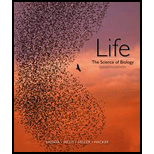
Concept explainers
To review:
The data observed from the given experiment in relation to the role of four phytochrome genes in leaf development.
Given:
Effect of differential expression of phy genes that code for phytochromes in Arabidopsis was studied by overexpression of these genes. Later, genetic screens were conducted to identify the mutant strains and their effect on the leaf elongation and size of leaf area was recorded.
Introduction:
Phytochromes are a type of photoreceptors that are present in plants. Photoreceptors detect light to which plant is exposed to and initiates a number of responses that lead to different developmental pathways in plants. These developments range from germination, de-etiolation to development of plant architecture, such as leaf area.
Explanation of Solution
The data given in the table indicate that four phytochromes present in Arabidopsis are involved in different developmental functions like the development of leaf architecture such as length of the leaves and area of the leaves. Since the mutants of these phytochromes show different phenotype from the wild-type, suggests that phytochromes play an important role in determining the area and length of leaves in the plant.
| Gene expression | Leaf area (mm2) |
| Wild-type | 22 |
| phyA overexpressed | 21 |
| phyB overexpressed | 21 |
| phyC overexpressed | 31 |
| phyD overexpressed | 22 |
Table: Phytochrome genes phyA, phyB, phyC, and phyD were separately overexpressed in Arabidopsis, and 18-day-old seedlings were examined with regard to leaf area.
These results also indicate that in some cases, the role of some of these phytochromes may be redundant. Redundancy means that the same function can be performed by a different phytochrome. In other cases, their roles may be overlapping or synergistic. The synergistic role means that two phytochromes may work together to create a certain effect on development. Some phytochromes play a greater role in controlling certain
Therefore, it can be concluded that the four phytochromes play different roles in the development of leaf area as well as elongation of leaf and these functions may be synergistic or redundant.
Want to see more full solutions like this?
Chapter 36 Solutions
Life: The Science of Biology
- What did the Cre-lox system used in the Kikuchi et al. 2010 heart regeneration experiment allow researchers to investigate? What was the purpose of the cmlc2 promoter? What is CreER and why was it used in this experiment? If constitutively active Cre was driven by the cmlc2 promoter, rather than an inducible CreER system, what color would you expect new cardiomyocytes in the regenerated area to be no matter what? Why?arrow_forwardWhat kind of organ size regulation is occurring when you graft multiple organs into a mouse and the graft weight stays the same?arrow_forwardWhat is the concept "calories consumed must equal calories burned" in regrads to nutrition?arrow_forward
- You intend to insert patched dominant negative DNA into the left half of the neural tube of a chick. 1) Which side of the neural tube would you put the positive electrode to ensure that the DNA ends up on the left side? 2) What would be the internal (within the embryo) control for this experiment? 3) How can you be sure that the electroporation method itself is not impacting the embryo? 4) What would you do to ensure that the electroporation is working? How can you tell?arrow_forwardDescribe a method to document the diffusion path and gradient of Sonic Hedgehog through the chicken embryo. If modifying the protein, what is one thing you have to consider in regards to maintaining the protein’s function?arrow_forwardThe following table is from Kumar et. al. Highly Selective Dopamine D3 Receptor (DR) Antagonists and Partial Agonists Based on Eticlopride and the D3R Crystal Structure: New Leads for Opioid Dependence Treatment. J. Med Chem 2016.arrow_forward
- The following figure is from Caterina et al. The capsaicin receptor: a heat activated ion channel in the pain pathway. Nature, 1997. Black boxes indicate capsaicin, white circles indicate resinferatoxin. You are a chef in a fancy new science-themed restaurant. You have a recipe that calls for 1 teaspoon of resinferatoxin, but you feel uncomfortable serving foods with "toxins" in them. How much capsaicin could you substitute instead?arrow_forwardWhat protein is necessary for packaging acetylcholine into synaptic vesicles?arrow_forward1. Match each vocabulary term to its best descriptor A. affinity B. efficacy C. inert D. mimic E. how drugs move through body F. how drugs bind Kd Bmax Agonist Antagonist Pharmacokinetics Pharmacodynamicsarrow_forward
 Biology (MindTap Course List)BiologyISBN:9781337392938Author:Eldra Solomon, Charles Martin, Diana W. Martin, Linda R. BergPublisher:Cengage Learning
Biology (MindTap Course List)BiologyISBN:9781337392938Author:Eldra Solomon, Charles Martin, Diana W. Martin, Linda R. BergPublisher:Cengage Learning Biology: The Dynamic Science (MindTap Course List)BiologyISBN:9781305389892Author:Peter J. Russell, Paul E. Hertz, Beverly McMillanPublisher:Cengage Learning
Biology: The Dynamic Science (MindTap Course List)BiologyISBN:9781305389892Author:Peter J. Russell, Paul E. Hertz, Beverly McMillanPublisher:Cengage Learning
 Biology 2eBiologyISBN:9781947172517Author:Matthew Douglas, Jung Choi, Mary Ann ClarkPublisher:OpenStax
Biology 2eBiologyISBN:9781947172517Author:Matthew Douglas, Jung Choi, Mary Ann ClarkPublisher:OpenStax Concepts of BiologyBiologyISBN:9781938168116Author:Samantha Fowler, Rebecca Roush, James WisePublisher:OpenStax College
Concepts of BiologyBiologyISBN:9781938168116Author:Samantha Fowler, Rebecca Roush, James WisePublisher:OpenStax College





